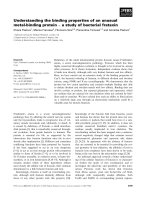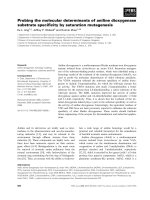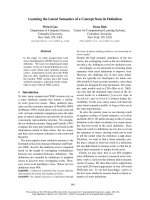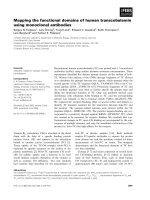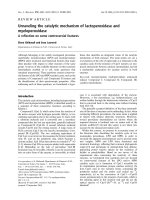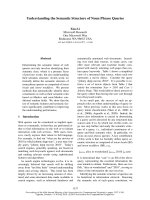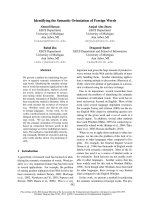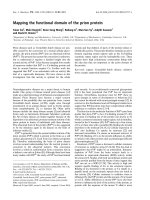báo cáo khoa học: "Understanding the relationship between the perceived characteristics of clinical practice guidelines and their uptake: protocol for a realist review" doc
Bạn đang xem bản rút gọn của tài liệu. Xem và tải ngay bản đầy đủ của tài liệu tại đây (652.51 KB, 9 trang )
STUD Y PRO T O C O L Open Access
Understanding the relationship between the
perceived characteristics of clinical practice
guidelines and their uptake: protocol for a realist
review
Monika Kastner
1*
, Elizabeth Estey
1
, Laure Perrier
1,2
, Ian D Graham
3
, Jeremy Grimshaw
3
, Sharon E Straus
1,4
,
Merrick Zwarenstein
5
and Onil Bhattacharyya
1,6
Abstract
Background: Clinical practice guidelines have the potential to facilitate the implementation of evidence into
practice, support clinical decision making, specify beneficial therapeutic approaches, and influence public policy.
However, these potential benefits have not been consistently achieved. The limited impact of guidelines can be
attributed to organisational constraints, the complexity of the guidelines, and the lack of usability testing or end-
user involvement in their development. Implementability has been referred to as the perceived characteristics of
guidelines that predict the relative ease of their implementation at the clinical level, but this concept is as yet
poorly defined. The objective of our study is to identify guideline attributes that affect uptake in practice by
considering evidence from four disciplines (medicine, psychology, management, human factors engineering) to
determine the relationship between the perceived characteristics of recommendations and their uptake and to
develop a framework of implementability.
Methods: A realist-review approach to knowledge synthesis will be used to understand attributes of guidelines (e.
g., its text and content) and how changing these elements might impact clinical practice and clinical decision
making. It also allows for the exploration of ‘what works for whom, in what circumstances, and in what respects’.
The realist review will be structured according to Pawson’s five practical steps in realist reviews: (1) clarifying the
scope of the review, (2) determining the search strategy, (3) ensuring proper article selection and study quality
assessment, (4) extracting and organising data, and (5) synthesising the evidence and drawing conclusions. Data
will be synthesised accordi ng to a two-stage analysis: (1) we will extract and define all relevant guideline attributes
from the different disciplines, then create a shortlist of unique attributes and investigate their relationships with
uptake, and (2) we will compare and contrast the attributes and guideline uptake within each and between the
four disciplines to create a robust framework of implementability.
Discussion: Creating guidelines that are designed to maximise uptake may be a potentially effective and
inexpensive way of increasing their impact. However, this is best achieved by a comprehensive framework to
inform the design of guidelines drawing on a range of disciplines that study behaviour change. This study will use
a customised realist-review approach to synthesising the literature to better understand and operationalise a
complex and under-theorised concept.
* Correspondence:
1
Li Ka Shing Knowledge Institute of St. Michael’s Hospital, Toronto, Ontario,
Canada
Full list of author information is available at the end of the article
Kastner et al. Implementation Science 2011, 6:69
/>Implementation
Science
© 2011 Ka stner et al; licensee BioMed Central Ltd. This is an Open Access article distributed under the terms of the Creative Commons
Attribution License (http://creati vecommons.org/lice nses/by/2.0), which permits unrestricted use, distribution, and reproduction in
any mediu m, provided the original work is properly cited.
Background
Clinical practice guidelines are ‘systematically developed
statements to assist practitioner and patient decisions
about appropriate health care for specific clinical cir-
cumstances’ [1,2]. Guidelines have the potential to facili-
tate the implementation of evidence into practice, but
these potential benefits have not been consistently
achieved [3-5]. The limite d impact of guidelines can be
attributed to inconsiste nt adoption in clinical practice
[2,6]. There are two general approaches to improving
uptake of guidelines: (1) extrinsic implementation strate-
gies , which target providers or practice environments to
increase guideline adherence, and (2) intrinsic imple-
mentation strategies, which target guideline developers
and end users to modify the guideline itself to facilitate
adherence. A comprehensive review found that overall
improvement in quali ty of care using extrinsic strategies
was generally modest [7], and costs, when measured,
were highly variable [7,8]. Intrinsic strategies that
address attributes of guidelines involve the interaction
between the guideline itself a nd the perceptions of its
end user. The ‘ characteristics’ of guidelines (such as
design and wording) may be perceived differently by dif-
ferent people; for example, what is clear to one person
may be confusing to another. We believe that if found
to be effective, optimising characteristics of guidelines
(as perceived by their end users) that are associated with
uptake could be routinely incorporated into gui deline
development at minimal cost. Desirable attributes of
guidelines, as described by the US Agency for Health
Care Policy and Research, include v alidity, reproducibil-
ity, reliability, clinical applicability, clinical flexibility,
and clarity [1,9]. Grol et al. found that guidelines that
are compatible w ith existing norms among the target
group a nd those that do not demand too much change
to existing routines, extra resources, or acquisition of
new knowledge and skills were used more [10]. Michi e
et al. suggest that clarity and specif icity of behavioural
instructions are important to get physicians to follow
guidelines but have largely been overlooked [11]. Their
work suggests that individuals are more successful at
changing their behaviour if they have a more specific
plan [12].
Shiffman et al. h ave referred to ‘ implementability’ as
the perceived characteristics of guidelines that predict
the relative ea se of th eir implementation [13]. E xisting
work on guideline implementability has been focused on
the m edical literature, but including disciplines focused
on changing human behavior, such a s psychology, mar-
keting, and human-factors engineering, may provide
deeper conceptualisation of its under pinnings, thereby
improving the potential for better uptake of guidelines
into clinical practice. Existing guideline tools asse ss the
methodological quality of guidelines [14], rate the
quality of evidence and strength of recommendations
[15], inform developers about potential problems with
implementation [13], and help adapt existing guidelines
into other settings [16]. Components of these tools
might contribute to successful implementation, but
most do not fully consider end-user needs, are not
info rmed by an explicit review of the relevant literature,
and do not completely operationalise the concept of
guideline implementability.
To better understand the concept of implementability
and the relationship between characteristics of guide-
lines and their uptake by physicians, t he objectives of
our study are to answer the following questions:
1. What works, for whom, in what circumstances in
relation to implementing guidelines?
2. What perceived characteristics of guidelines affect
uptake of evidence-based recommendations in four
disciplines: m edicine, psychology, management, and
human-factors engineering?
3. What is the relationship between the perceived
characteristics of recommendations and their uptake
by clinicians?
4. Which perceived characteristics o f recommenda-
tions are most closely associated with uptake?
5. How are these perceived characteristics repre-
sented in the context of each of the four disciplines?
Methods
The selection of our study methods was guided expli-
citly by our research questions. To select the most
appropriate synthesis method, we assessed 10 potentially
relevant review methodologies [17-21] and classified
their features a s being idealist or realist. Of the 10
synthesis methods, we identified the realist review [22],
meta-narrative synthesis [23], and meta-ethnography
[24] as the most potentially relevant for answering our
research questions. We interrogated each of these three
methods to decide which would be the most appropriate
to use as our primary synthesis method in the context
of our research questions.
Realist reviews provide a structured approach to a
‘ compl ete’ review, i ncluding sampling, study quality
assessment, data extraction, and analysis. They are help-
ful for interrogating underlying theories and mechan-
isms of implementability (i.e., how the attributes of
guidelines affect upt ake) and encourage the inclusion of
quantitative and q ualitative evidence. However, realist
reviews lack a comprehensive process to compare disci-
plinary perspectives on a given issue. Meta-narrative
synthesis is helpful for analysing data across different
fields , constructing the narrative within a discipline, and
comparing them between disciplines. However, it may
notbeabletointerpretthespecificintrinsicattributes
Kastner et al. Implementation Science 2011, 6:69
/>Page 2 of 9
of guidelines and their relationship with uptake. Meta-
ethnography offers a systematic approach to synthesis to
better understand specific attributes of guidelines and
their relationship with uptake, but it considers only qua-
litative studies for inclusion and is a mean s of analysis
only, offering little guidance on the complete process for
conducting a review. Since none of the review methods
are a ‘perfect’ fit, we will adopt a more flexible approach
to reviewing the literature. We will select the realist
review as our primary review method because it has the
most potential for answering the majority of our
research quest ions, is a structured and relatively trans-
parent approach to conduc ting the review, and allows
for the inclusion of both quantitative and qualitative evi-
dence. During the analysis phase of the review, we will
use realist-review analysis methods, but will also incor-
porate qualitative analysis techniques borrowed from
meta-ethnography to translate definitions of guideline
attributes between disciplines, condense them into a
comprehensive set of unique attributes, and describe the
relationships among them.
Realist-review methodology
Pioneered by Ray Pawson, the realis t review is an expli-
citly theory-driven approach to the synthesis of evi-
dence-it seeks to interrogate the t heories that underpin
the programs or interventions being studied [22]. A rea-
list synthesis takes a ‘generative’ approach to causation,
that is, ‘ to infer a causal outcome (O) between two
events (X and Y), one needs to understand the underly-
ing mechanism (M) that connects them and the context
(C) in which the relationship occurs’ [25]. Its primary
focus is to test the causal mechanisms or ‘ theories of
change’ behind interventions or programmes. In the
context of guideline implementability, a realist review
can thus facilitate the careful examination and under-
standing of the attributes of guidelines (e.g., its text,
content, and presentation) and how changing these
attributes might impact clinical decision making for
physicians. A further benefit of the realist-review
approach is that it seeks to explore ‘what works for
whom, in what circumstances, and in what respects’
[22]. Other strengths of this approach are that it engages
stakeholders throughout the review process and
encourages the inclus ion of diverse types of evidence (i.
e., quantitative and qualitative) so that the processes and
impacts of interventions can be investigated [22]. The
current study will use five steps adapted from Pawson’s
practical steps in realist reviews [22,26].
Step 1: clarifying the scope of the review
In a realist review, the inquiry is targeted to answering
why, when, and how an intervention may or may not suc-
ceed [22,26]. In the context of guideline implementability,
it will aim to build explanations across interventions that
share similar underlying theories of change about why
practice guidelines are not implemented successfully or
why they do or do not facilitate knowledge uptake, for
whom, in what circumstances, and how. This method is
different from traditional systematic reviews, where the
general approach to determining the research question(s)
is to inquire simply whether a particular intervention
works. The two a pproaches are nonoverlapping-realist
reviews cannot answer whethe r something works, and
quantitative systematic reviews will almost never have suf-
ficient trials to answer how and why something works.
We will use several strategies to refine the purpose of
the review. Using a theory-integrity strategy (i.e., does
the intervention work as predicted), we will attempt to
reveal the ‘typical weak points and stumbling blocks in
the history of the intervention’ (in our work, the inter-
vention will be defined as clinical practice guidelines)
[22]. We will also try to uncover evidence to a djudicate
between rival theories for uptake of guideline recom-
mendations and to identify which alternate mechanism
is most successful. Additionally, an important strategy
will be to perform an exercise to determine for whom
and in what circumstances guidelines are implemented
successfully. This will be done by uncovering studies of
the same strategies for guideline uptake but i n different
settings to identify the ‘winners and losers’ . This will
clarify our un derstanding of why certain strategies work
only under c ertain circumstances and for only certain
populations [22], and may also reveal which attributes
of guidelines influence their uptake.
Key theories to be explored
Prior to conducting the review, the body of working the-
ories that ‘lies behind the intervention’ needs to be iden-
tified. Pawson suggests tapping into stakeholders and
experts as an initial strategy to help frame the problem
[22,26]. Our approach to exploring key theories will
begin by consulting with clinician scientists a nd experts
in guideline development and knowledge translation to
better understand perceptions of guideline implement-
abilitybeforesearchingtheliteraturetoidentify‘the-
ories, hunches, expectations, and the rationalizations’ for
whytheymayormaynotfacilitateknowledgeuptake
[22,25]. The goal of this exercise is not to collect data
about the efficacy of guidelines but to identify a range
of theories and explanations for how guidelines are sup-
posed to work (and for whom), when they do work,
when they don’t achieve the desired change in practices,
why they are not effective in this, and why they are not
being used. The body of literature from exploring key
theories will be representative of our first stage of litera-
ture searching (i.e., the core articles search as described
below), from which we will build a working list of
Kastner et al. Implementation Science 2011, 6:69
/>Page 3 of 9
candidate th eories (i.e., middle-range or ‘educated guess’
theories). These candidate theories will be continuously
tested and appended as they evolve (or new theories
emerge) and will be finalised only when their validity
has been teste d and e xplored during the re alist-review
process [22,27].
Well-studied theories related to changing behaviour
include the Social Cognitive Theory [28], the Theory of
Reasoned Action [29], the Theory of P lanned Behaviour
(TPB) [30], the health belief model [31], stages of readi-
ness to change [32], and Rogers’ Diffusion of Innova-
tions Theory [33]. T o guide our exploration of which
perceived factors influence guideline adherence, we w ill
use the TPB, as it is the most widely r esearched, influ-
ential, and empirically based framework designed to pre-
dict and explain human behaviour in specific contexts
[30,34]. According to the TPB, human behaviour is
guided by three types of motivational factors that can
lead to intention to perform the target behaviour: (1)
attitudes toward the behavior, (2) subjective norms (i.e.,
aperson’s perception of inju nctive norms [behaviours
perceived as being approved by other people] a nd
descriptive norms [people’s perception of what is com-
monly done in specific situations]), and (3) perceived
behavioural control [30]. In the context of guideline
implementability, the central behavioural goal is to ‘use’
or ‘ uptake’ guidelines. These intentions can be illu-
strated accordi ng to the three conceptually i ndependent
predictor variables. The first can be conceptualised as
the attitude or behavioural beliefs toward using guide-
lines and refers to the degree to which a person has a
favourable or unfavourable evaluation of this beha-
vioural goal (i.e., the strength of their intention or moti-
vation). The second predictor is normative beliefs (i.e.,
the subjective norm), which refers to the perceived
social pressure to use or not use guidelines. The third
predictor is the degree of perceived behavioural control,
which can be conceptualised as the perceived ease or
difficulty of performing guideline use or uptake. This
may reflect past experiences as well as anticipated impe-
diments and obstacles of the behaviour. Together, these
three predictor factors can lead to the formation of
behavioural intention. In general, we can predict that
the more favourable the attitude and subjective norm
with respect to using guidelines, and the greater the per-
ceived control, the stronger the individual’s intention to
adhere to them. Intention is thus an immediate antece-
dent of guideline use, but the degree of success will also
depend on other nonmotivational factors, such as avail-
ability of requisite opportunities and resources (e.g.,
time, resources, skills, willpower) [30]. Based on the
TPB, it is expected that intentions to use/uptake guide-
lines will be predicted from attitud es, subjective no rms,
and perc eived con trol with respect to t his goal and that
intentions and perceived control may in turn permit
prediction of actual adherence to guidelines.
Preliminary list of candidate theories
Our preliminary list of candidate theories are as follows:
1. Clinical practice guidelines are not used by physi-
cians in part because of specific perceived guideline
characteristics (i.e., attributes of implementability).
For example, guidelines and their recommendations
are too complex, lengthy, and time consuming to
useandaredifficulttofollow(e.g., ambiguous
language)
2. There are ‘trad e-offs’ between various guideline
attributes that hinder or facilitate uptake (the exami-
nation of the trade-offs betwee n the various dimen-
sions will help clarify our under standing of how and
why this theory makes sense).
Step 2: determining the search strategy
There are two key differences in search ing between rea-
list reviews and traditional systemat ic reviews. In reali st
reviews, there is no finite set of relevant articles that can
be defined and then fo und. In contrast, traditional sys-
tematic reviews often take a linear, time-restricted
approach to searching the literature, striving for comple-
teness by attempting to identify every single paper on a
given topic or intervention [22,35]. The second differ-
ence is that primary studies in realist reviews are rarely
the unit of analysis, so studies are not excluded b ased
on rigour, as this would reduce rather than increase the
validity and generalisability of the findings. Instead, it is
the relevant elements of the primary study that are
tested for specific hypotheses about the link between
context, mechanism, and outcome [22]. We initially
attempted a traditional search with text words and
MeSH terms (identified from the preliminary list of 20
relevant core articles) in MEDLINE using an Ovid (Ovid
Technologies, Inc., New York, NY, USA) interface to
verify whether this strategy would have merit for captur-
ing other potentially relevant articles. Of the over 5,000
articles that were generated,only8ofthe20relevant
core articles were identified (40%), indicating that this
strategy would likely be ine fficient and resource inten-
sive (e.g., duplicate reviewing from a large search retrie-
val with a low potential for identifying relevant articles).
This finding is consistent with Greenhalgh et al.’s review
of complex evidence (the diffusion of service-level inno-
vations in healthcare organisations) [36], which found
that protocol-driven search strategies performed poorly
when identifying potentially relevant articles for sys-
tematic reviews of complex evidence-only 30% of their
sources were identified through protocol-driven
Kastner et al. Implementation Science 2011, 6:69
/>Page 4 of 9
strategies (i.e ., electronic database and hand searching),
whereas snowball sampling (i.e., reference and citation
tracking) yielded the majority of relevant articles ( 51%)
[37]. In fact, recent work has shown that asking experts
where to look for potentially relevant articles is an effec-
tive strategy [37,38]. We will thus use snowball sampling
to identify experts in the four discipline areas, who will
then be consulted to direct us where to look for and
identify potentially relevant literature and concepts.
We will use the multiple-search strategy approach of
realist reviews, which seeks to explore and contextu alise
the intervention in multiple settings. This will thus be
an iterative, interactive, and purposive sampling strategy
with no predefined sampling frame [26,35]. Searching
will resemble the sampling strategies of qualitative
research: purposive, snowball (i.e., manually searching
for references of references or the process of i dentifying
cases from people who know people who have relevant
information), or opportunistic sampling for information-
rich cases, with the goal of retrieving materials to
answer specific questions or to test particular theories.
This process requires taking a more flexible and iterative
approach to the l iterature to capitalise on unanticipated
findings. We will also consider a model of searching
called ‘berrypicking’ , which asserts that typical search
queries are not static but evolve, gather information in
‘bits and pieces rather than in one grand best retrieved
set’ , and use a wide variety of search techniques and
sources beyond common bibliographic databases such as
MEDLINE [39]. Our strategy will thus consist of five
nonlinear and iterative stages of searchin g (see Figure 1
for the algorithm of this process), as outlined below.
Stage 1: background search for core articles
The purpose of the background search is t o ‘get a feel
for the literature’ to determine wha t and how much
information exists, in what form, and where it is. We
gathered a preliminary core set of articles using a ‘de sk
drawer’ search strategy (i.e., going through existing
materials of the research team). We then conducted a
scoping review in MEDLINE and EMBASE using the
following initial list of search terms, which were com-
piled from the collective knowledge of our research
team consisting of clinician scientists and knowledge-
translation researchers: ‘ implementability/implementa-
tion’ , ‘ clinical practice guidelines’ , ‘ knowledge
translation’.
Stage 2: expert-identified searching from multiple
disciplines
To gather the comprehensive evidence needed, our
strategy will involve searching the literature across four
different disciplines relevant to the topic (i.e., medicine,
psychology, management, a nd human-factors engineer-
ing), as we bel ieve this will provide a broader insight
into the concept o f implementability. Snowball sampling
will be used to identify experts in the four discipline
areas, who will then be consulted to direct us where to
look for and identify potentially relevant literature and
concepts. This may also involve purposively searching
discipline-specific databases for articles suggested by key
experts in the four discipline areas.
Stage 3: PubMed related-articles searching
We will search for additional articles by utilising the
Related Articles feature in PubMed for articles retrieved
from the various search stages and those deemed highly
relevant by the core research team (limited to articles
published between 2000 and 2010). This strategy was
selected because previous work to identify optimal
approaches to updating systematic reviews [40] or to
verify that potentially relevant articles were not missed
in a systematic review [41] has shown that the Rela ted
Articles feature in PubMed can identify most new ‘sig-
naling evidence’ with a relatively low screening burden
of new records per review [40,41].
Stage 4: bibliographic searching of relevant articles
We will look for other potentially relevant articles using
snowball sampling (i.e., scanning the reference lists of
relevant articles) from stage 1 (core articles) and stage 2
(expert directed) searching.
Stage 5: other types of searching
We will look for other potentially relevant articles by
purposively scanning the literature of key authors and
the articles discovered through snowball and opportu-
nistic sea rchin g and serendipitous discovery. This stage
will also include searching for grey literature: (a) web-
sites, such as those for the Agency f or Healthcare
Research and Quality, Institute of Medicine, and various
Figure 1 Search schematic of the Realist Review.
Kastner et al. Implementation Science 2011, 6:69
/>Page 5 of 9
foundations (e.g., Ro bert Wood Johnson Foundation),
and (b) approaching each discipline expert to identify
unpublished documents (e.g., the Guideline Implementa-
tion Network and the National Guideline Clearing house
[Expert Commentaries, AGREE {Appraisal of Guideline
Research and Evaluation} Collaboration]).
Deciding when to stop searching
Setting a threshold for stopping the search is an impor-
tant consideration for conducting systematic reviews . In
realist reviews, searching continues in a cyclical and
iterative process that is not designed to be exhaustive.
However, it remains important to not only create para-
meters to decide which studies are ‘ fit’ for identifying,
testing, or refining the theories but also to decide when
a sufficient amount of e vidence has bee n assembled to
satisfy the theoretical need (i.e., to reach theoretical
saturation) or to answer the research questions [ 22,35].
Pawson suggests that the ‘ test of saturation’ can be
applied iteratively, by asking after each stage or cycle of
searching whether the latest sample of literature has
added anything n ew to our understanding of the inter-
vention and whethe r further searching is likely to add
new knowledge [22,35]. As such, it is not possible to
state the stopping point of searching apriorior to
determine the number of studies at which th eoretical
saturation will occur. However, the reporting of this
process w ill be transparent, and each step will be care-
fully documented.
Step 3: article selection and study quality assessment
Although realist reviews acknowledge the principle that
a quality filter should be applied at s ome point during
the evidence synthesis, Pawson rejects the ‘hierarchy of
evidence’ approach to study quali ty assessment [22]. He
argues that multiple methods are needed to ‘illuminate
the richest picture’ [22].Thisinvolvestestingforrele-
vance (i.e., does the research address the theory under
investigation, why guidelines are not implemented and
in what cont ext this occurs?) and rigour (i.e., does the
research support the conclusions drawn from it?) [22].
Two reviewers will independently select articles (during
title/abstract and full-text review) using a preliminary
set of inclusion/exclusion criteria (which will evolve dur-
ing the process of the review) (see Additional file 1).
The purpose of the duplicate article- review process is
partly to ensure a certain level of rigour (i.e., to correctly
interpret the inclusion/exclusion criteria because we
anticipate a steep learning curve). We also anticipate
that the duplicate review process will serve as a great
platform for reflexive discussion that will enable
informed decisions among reviewers for identifying rele-
vant data [38]. If t here is strong agreement, it would
possibly reduce the number of articles that would need
to be reviewed in duplicate, given that we anticipate a
high volume of potentially relevant articles. Inclusion
criteria are articles that prov ide information about
guideline attributes, address any aspect of why guide-
lines are not implemented for intrinsic reasons, and
include perceptions of guideline developers or end users
(e.g., physician p roviders) about intrinsic factors that
influence intentions to use guidelines. We will define
guidelines in other disciplines as any recommendations
or guidance for behaviours that are consistent with
those of clinical practice guidelines in medicine (and
implementability will be defined as the uptake of recom-
mendations). For example, guidelines might include
instructions for mortgages or financial statements (man-
agement) and technical manuals for products (human-
factors engineering). Exclusion criteria are opinion-dri-
ven studies (i.e., editorial reviews, commentaries, and
letters), non-English language articles, articles that focus
on how guidelines were developed or do not discuss the
reasons for why guidelines are not implemented, and
articles that discuss guideline implementation strategies
that are extrinsic.
The process for determining ‘rigour’ is described by
Pawson in terms of ‘ whether a particular inference
drawn by the authors has sufficient weight t o make a
methodologically credible contribution to the test of a
theory’ and to apply ‘ judgment’ to supplement formal
critical appraisal checklists (if they are used) [22]. Apply-
ing judgment cannot be translated into a technical pro-
cedure, which is likely the reason why it has not been
described in detail in published examples of realist
reviews [ 27,42]. Our strategy will be to use rigour as a
mediating tool rather than a testing method for article
selection so that we can determine which studies best fit
our purpose (e.g., for studies that have the same con-
cepts but with differing methodological rigour or to
adjudicate b etween studies that have similar meth odolo-
gies but conflicting results).Wewillapplyjudgmentto
resolve conflicts amongst reviewers by considering
whether the results can be applied to the context of
healthcare providers using clinical practice guidelines.
We want to be careful not to exclude articles based on
methodological rigour alone, as the primary studies con-
tribute different elements to the rich picture that consti-
tutes the overall synthesis of evidence. In realist reviews,
the study itself is rarely ever used as the unit of analysis;
instead, realist reviews may consider small sections of
the primary study (e.g., the Introduction or Discussion
sections) to test a very specific hypothesis about the
relationships between context, mechanism, and out-
comes [22]. We will thus select and review studies
based on what new knowledge they bring to our think-
ing about the theory of implementability. The meaning
and value of rigour will then be defined, examined, and
Kastner et al. Implementation Science 2011, 6:69
/>Page 6 of 9
documented for each article. For example, we will docu-
ment whether the source of an explanation for why
guidelines are not implemented is supported by evi-
dence or author opinion within the article. We will then
use this information to mediate between studies of vari-
able quality but with comparable relevance. The impor-
tance of transparency in the realist-review process
parallels systematic revi ews, to ensure that findings and
conclusions are valid, reliable, and verifiable [26,35].
Step 4: extracting and organising data
Two researchers will independently extract data from all
potentially relevant full-text articles using a standardised
data collection form, including the article citation, at
which level it was searched (e.g., stage 2 expert-identi-
fied searching), discipline ( e.g., medicine, psychology),
study design, relevance, and the name and author’s defi-
nition and operationalisation of the guideline attribute
that was discussed in the article (see example in Add i-
tional file 2). However, interpretation of this data will be
guided by judgment of the reviewers.
Step 5: synthesising the evidence and drawing
conclusions
We will synthesise data using several analytic
approaches. First, we will use the realist-review approach
to interrogate our final theory, which will be to deter-
mine ‘ what is it about practice guidelines that works (i.
e., to facilitate uptake), for whom, in what circum-
stances, in what respects, and why’. We will then borrow
synthesis methods from meta-ethnography to identify
and interrogate specific guideline attributes and their
potential trade-offs as well as their relationship with
uptake by physicians [24]. The process of analysis will
thus follow a two-level analysis, where the data will get
further dissected and refined with each level of analysis.
Level 1: realist-review analysis [22,35]
We will first explore what have been the typical weak
points and m ajor stumbling blocks (i.e., the barriers and
facilitators) of guideline implementation by family physi-
cians. The logic behind this approach is that interven-
tions are on ly as strong as their weakest link. We will
then look for rival theories of implementability (if they
exist) to refine the understanding of how practice guide-
lines work by using evidence to ‘ adjudicate’ between
these rival theories of implementability. Next, we will
consider the same theory in different settin gs. This
approach assumes that particular interve ntion theories
may work in some settings but not in others. We will
attempt to make sense of the patterns of data that relate
to the facilitator and barrier circumstances in which
guidelines are successfully implemented or not. Finally,
we will attempt to synthesise the data by comparing
official expectations with actual practice (i.e., the expec-
tation that family physicians will use clinical practice
guidelines even though evidence indicates otherwise).
This approach is particularly useful for comparing the
‘offi cial ’ theory (i.e., what specific content in guidelines
should be used in what circumstances and how) and
what actually happens in practice.
Stage 2: qualitative analytic techniques
Although the realist-review analysis technique is h elpful
for interrogating our underlying theory, it lacks the pro-
cess fo r interpreting the specific a ttributes of guideline
recommendations that may facilitate guideline uptake
and the process for associating the relationship s among
these dimensions to better understand their anticipated
trade-offs. For this purpose, we will use various qualita-
tive analytic techniq ues, drawing from Noblit and Hare’s
meta-ethnography [24]: reciprocal translation analysis
(RTA), which can be used for instances when the
accounts in an article a re similar; refuta tional analysis,
which can be used when the accounts are contradict ory
and an attempt is made to explain them; and line of
argument (LOA) analysis, which can be used when
inferences can be made by building up a picture
grounded in the findings of separate studies. These
three methods will be used to generate a complete list
of unique guideline attributes and their definitions and
will represent both an integrative and interpretive
approach to revealing the relationships between guide-
line attributes and uptake [18,24,43].
RTA and refutational methods will first be used to
translate definitions of guideline attributes from differ-
ent disciplines into one a nother (i.e., how a concept in
one paper is included in interpretations offered by other
papers) and then LOA analysis will be u sed to come up
with second- or third-order interpretations. For exam-
ple, themes can be compared across studies and
matched from one study to another (using RTA), ensur-
ing that a key theme captures similar themes from dif-
ferent studies. We will begin this process by creating a
list of themes or metaphors related to guideline attri-
butes and determining how they are related (e.g., we
might end up with different terms or definitions for the
same attribute or the same attribute with different terms
or definitions). This integrative approach allows these
terminologies to be combined so that the differences
between attribute terms can be negotiated to decide
which might be the most relevan t in the context of
medicine. The RTA can then proceed to higher-order
interpretations using the LOA synthesis method.
According t o Schutz’s notions of ‘orders’ of constructs
[44], synthesis and interpretation of first- and second-
order constructs can be further distilled to reveal a new
model, theory, or understanding (i.e., third-order
Kastner et al. Implementation Science 2011, 6:69
/>Page 7 of 9
interpretation) [45]. For example, first-order interpreta-
tions may represent the gener al understanding of guide-
line attributes as it relates to implementabil ity and
second-order interpretations may represent the explana-
tions and theories used by authors in primary study
reports ( i.e., how the study author understands the con-
cept). It is possible to then build on and extend these
interpretations to r eveal third-order constructs, which
represent a new model, theory, or understanding. For
example, the way in which guideline implementability is
understood in the four disciplines (second-order inter-
pretation) may be distilled further to reveal their rele-
vance in the context of medicine (third-order
interpretation). The output from these analyses is called
the ‘synthesizing argument’, which represents the inte-
gration of evidence across studies into a coherent theo-
retical framework (similar to the analysis that is done in
primary qualitative research) [18]. RTA and LOA synth-
esis meth ods will thus enable the organisation of guide-
line attributes and their trade-offs and interpret them
according to how their relationships can be mapped to
reveal the implications of these trade-offs in clinical
practice.
Discussion
Implementation research is complex, given the int erplay
of patient-, provider-, organisation-, and system-level
factors. This is likely why the impact of implementation
strategies has been modest, and general conclusions
about which strategy should be applied in what context
have been so limited [44]. Our work will help explain
the intrinsic reasons for why and under what circum-
stances guidelines are n ot being implemented. This will
be an important first step toward better understanding
which attributes of guidelines have the potential to
improve uptake in clinical practice. Dependin g on the
findings, we will attempt to organise the results into a
conceptual framework of implementability and identify
attributes that can feasibly be changed during the guide-
line-development process.
Our work also represents a novel a pproach to kn owl-
edge synthesis. We will test how the use of a customised
approach to synthesising t he literature can answer
research quest ions around a complex and un der-
theorised concept such as guideline implementability.
Although we initially considered conducting a systematic
review, there is increasing evidence that this may not be
the most appropriate method for investigating complex
and multidisciplinary topics [37]. Analysis of opposing
epistemologies helped short-list potentially relevant
synthesis methodologies, but in the process of choosing
the realist review as the primary synthesis method, we
discovered that many underlying principles of other
synthesis methods were highly applicable but
insufficiently covered all our questions-we had to use a
hybrid model as there was no perfect fit with any of the
available methods. This highlights the need for a more
flexible approach to conducting literature syntheses of
complex evidence, which may require borrowing relevant
components of existing synthesis methods in coordina-
tion with a primary synthesis method (including
Cochrane-style reviews) to complete the review . There is
aneedtoshiftthewaywethinkaboutandconduct
reviews of complex interventions and recognise that tra-
ditional systematic revie ws may not a lways be the most
appropriate. We should approach answering synthesis
questions the same way we do when deciding the most
appropriate study design for a primary study-by matching
the appropriate design to fit the question or considering a
mixed-methods design to better understand the how and
why of effectiveness findings. In our study, we will show
that a realist-review-informed synthesis combined with
analysis components of meta-narrative and meta-ethno-
graphy techniques can be an effective strategy for disco-
vering the unique attributes of guidelines that affect
uptake across the disciplines of medicine, psychology,
management, and human-factors engineering.
Additional material
Additional file 1: Inclusion/exclusion criteria.
Additional file 2: Example of the data extraction form.
Author details
1
Li Ka Shing Knowledge Institute of St. Michael’s Hospital, Toronto, Ontario,
Canada.
2
Continuing Education and Professional Development, Faculty of
Medicine, University of Toronto, Toronto, Ontario, Canada.
3
Department of
Epidemiology and Community Medicine, Ottawa Health Research Institute,
University of Ottawa, Ottawa, Ontario, Canada.
4
Faculty of Medicine,
University of Toronto, Toronto, Ontario, Canada.
5
Sunnybrook Research
Institute, Toronto, Ontario, Canada.
6
Family and Community Medicine,
University of Toronto, Toronto, Ontario, Canada.
Authors’ contributions
All authors participated in the design of the study. MK drafted the
manuscript, and all authors reviewed and approved the final manuscript.
Competing interests
The authors declare that they have no competing interests.
Received: 1 February 2011 Accepted: 6 July 2011 Published: 6 July 2011
References
1. Institute of Medicine: Guidelines for Clinical Practice: From Development to
use National Academic Press, Washington; 1992.
2. Kendall E, Sunderland N, Muencheberger H, Armstrong K: When guidelines
need guidance: considerations and strategies for improving the
adoption of chronic disease evidence by general practitioners. J Eval Clin
Prac 2009, 15:1082-90.
3. Grimshaw J, Eccles M, Thomas R, MacLennan G, Ramsay C, Fraser C, Vale L:
Toward Evidence-Based Quality Improvement. JGIM 2006, 21:S14-20.
4. Gagliardi AR, Brouwers M, Palda VA, Lemieux-Charles L, Grimshaw JM: An
exploration of how guideline developer capacity and guideline
Kastner et al. Implementation Science 2011, 6:69
/>Page 8 of 9
implementability influence implementation and adoption: study
protocol. Impl Sci 2009, 4:36.
5. Russell IT: Effect of clinical guidelines on medical practice: a systematic
review of rigorous evaluations. Lancet 1993, 342:1317-1322.
6. Brown LC, Johnson JA, Majumdar SR, Tsuyuki RT, McAllister FA: Evidence of
suboptimal management of cardiovascular risk in patients with type 2
diabetes mellitus and symptomatic atherosclerosis. CMAJ 2004,
171(10):1189-1192.
7. Grimshaw JM, Eccles MP: Is evidence-based implementation of evidence-
based care possible? MJA 2004, 180:S50-S51.
8. Grimshaw JM, Thomas RE, MacLennan G, Fraser C, Ramsay CR, Vale L,
Whitty P, Eccles MP, Matowe L, Shirran L, Wensing M, Dijkstra R,
Donaldson C: Effectiveness and efficiency of guideline dissemination and
implementation strategies. Health Technol Assess 2004, 8(6):iii-iv, 1-72.
9. Grimshsaw J, Russell I: Achieving health gain through clinical guidelines I:
Developing scientifically valid guidelines. Qual Health Care 1993,
2:243-248.
10. Dalhuijsen J, Thomas S, Veld C, Rutten G, Mokink H: Attributes of clinical
guidelines that influence use of guidelines in general practice:
observational study. BMJ 1998, 317:858-61.
11. Michie S, Johnston M: Changing clinical behaviour by making guidelines
specific. BMJ 2004, 328:343-5.
12. Gollwitzer PM: Implementation intentions: strong effects of simple plans.
Am Psychol 1999, 54:493-503.
13. Schiffman R, Dixon J, Brandt C, Essaihi A, Hsiao A, Michel G, O’Connell R:
The Guideline Implementability Appraisal (GLIA): development of an
instrument to identify obstacles to guideline implementation. BMC Med
Info Dec Mak 2005, 5:23.
14. Brouwers MC, Kho ME, Browman GP, Burgers JS, Cluzeau F, Feder G,
Fervers B, Graham ID, Grimshaw J, Hanna SE, Littlejohns P, Makarski J,
Zitzelsberger L, AGREE Next Steps Consortium: AGREE II: Advancing
guideline development, reporting and evaluation in health care. CMAJ
2010.
15. GRADE Working Group: Grading quality of evidence and strength of
recommendations. BMJ 2004, 328:1490.
16. Brugers JS, Haugh MC, Latreille J, Milka-Cabanne N, Paquet L, Coulombe M,
Poirier M, Burnand B: Adaptation of clinical guidelines: literature review
and proposition for a framework and procedure. Int J Qual Health Care
2006, 18(3):167-76.
17. Barnett-Page E, Thomas J: Methods for the synthesis of qualitative
research: a critical review. BMC Med Res Method 2009, 9
:59.
18. Dixon-Woods M, Agarwal S, Jones D, Young B, Sutton A: Synthesizing
qualitative and quantitative evidence: a review of possible methods. J
Health Serv Res Policy 2005, 10(1):45-53.
19. Mays N, Pope C, Popay J: Systematically reviewing qualitative and
quantitative evidence to inform management and policy-making in the
health field. J Health Serv Res Policy 2005, 10(1):6-20.
20. Grant MJ, Booth A: A typology of reviews: an analysis of 14 review types
and associated methodologies. Health Information and Libraries Journal
2009, 26:91-108.
21. Thomas J, Harden A: Methods for the thematic synthesis of qualitative
research in systematic reviews. BMC Med Res Meth 2008, 8:45.
22. Pawson R, Greenhalgh T, Harvey G, Walshe K: Realist review-a new
method of systematic review designed for complex policy interventions.
J Health Serv Res Policy 2005, 19(Suppl1):S21-S34.
23. Greenhalgh T, Robert G, Macfarlane F, Bate P, Kyriakidou O, Peacock R:
Storylines of research in diffusion of innovation: a meta-narrative
approach to systematic review. Soc Sci & Med 2005, 61:417-30.
24. Noblit GW, Hare RD: Meta-ethnography: synthesizing qualitative studies
Newbury Park, California, Sage; 1988.
25. Pawson R: Evidence Based Policy: II. The Promise of ‘Realist Synthesis’ ESRC UK
Centre for Evidence Based Policy and Practice (Working paper 4); Queen
Mary University of London; 2001.
26. Pawson R, Greenhalgh T, Harvey G, Walshe K: Realist Synthesis: an
introduction ESRC Research Methods Programme, University of Manchester
RMP Methods Paper 2/2004.
27. Wong G, Greenhalgh T, Pawson R: Internet-based medical education: a
realist review of what works, for whom and in what circumstances. BMC
Med Ed 2010, 10:12.
28. Bandura A: Social Foundations of Thought and Action: A Social Cognitive
Theory Englewood Cliffs, NJ, Prentice Hall; 1986.
29. Ajzen I, Fishbein M: Understanding Attitudes and Predicting Social Behavior
Englewood Cliffs, NJ, Prentice Hall; 1980.
30. Ajzen I: The theory of planned behavior. Organizational Behavior and
Human Decision Processes 1991, 50:179-211.
31. Janz NK, Becker MH: The health belief model: a decade later. Health
Education Quarterly 1984, 11:1-47.
32. Prochaska JO, DiClemente CC: Stages and processes of self-change of
smoking: toward an integrated model of change. Journal of Consulting
and Clinical Psychology 1983, 51:390-395.
33. Rogers EM: Lessons for guidelines from the diffusion of innovation. Joint
Commission Journal on Quality Improvement 1995, 21
:324-328.
34. Armitage CJ, Conner M: Efficacy of the Theory of Planned Behaviour: A
meta-analytic review. British Journal of Social Psychology 2001, 40:, 471-499.
35. Pawson R: Evidence-based Policy. A Realist Perspective London: Sage; 2006.
36. Greenhalgh T, Robert G, Bate P, MacFarlane F, Kyriakidou O: Diffusion of
Innovations in Health Service Organisations: A systematic literature review
Blackwell Publishing Ltd; 2005.
37. Greenhalgh T, Peacock R: Effectiveness and efficiency of search methods
in systematic reviews of complex evidence: audit of primary sources.
BMJ 2005, 331:1064-1065.
38. Greenhalgh T, Potts H, Wong G, Bark P, Swinglehurst D: Tensions and
paradoxes in electronic patient record research: A systematic literature
review using the meta-narrative method. Milbank Quarterly 2009,
87(4):729-788.
39. Bates MJ: The design of browsing and berrypicking techniques for the
online search interface. Graduate School of Library and Information
Science, University of California at Los Angeles 1989; 2011 [a.
edu/faculty/bates/berrypicking.html].
40. Shojania KG, Sampson M, Ansari MT, Ji J, Garritty C, Rader T, Moher D:
Updating Systematic Reviews. ACHRQ Technical Review 2007 Number 16 .
41. Kastner M, Straus SE, McKibbon KA, Goldsmith CH: The capture-mark-
recapture technique can be used as a stopping rule when searching in
systematic reviews. JCE 2009, 62:149-157.
42. Walshe C, Luker KA: District nurses’ role in palliative care provision: A
realist review. International J Nursing Studies 2010, 47:1167-83.
43. Pound P, Pope C, Britten N, Pill R, Morgan M, Donovan J: Evaluating meta-
ethnography: a synthesis of qualitative research on lay experiences of
diabetes and diabetes care. Soc Sci & Med 2003, 56:671-684.
44. Straus SE, Tetroe J, Graham ID: Knowledge Translation in Health Care: Moving
from Evidence to Practice Blackwell Publishing Ltd; 2009.
45. Schutz A: In Collected Papers. Volume I. The Hague: Martinus Nijhoff; 1962.
doi:10.1186/1748-5908-6-69
Cite this article as: Kastner et al.: Understanding the relationship
between the perceived characteristics of clinical practice guidelines and
their uptake: protocol for a realist review. Implementation Science 2011
6:69.
Submit your next manuscript to BioMed Central
and take full advantage of:
• Convenient online submission
• Thorough peer review
• No space constraints or color figure charges
• Immediate publication on acceptance
• Inclusion in PubMed, CAS, Scopus and Google Scholar
• Research which is freely available for redistribution
Submit your manuscript at
www.biomedcentral.com/submit
Kastner et al. Implementation Science 2011, 6:69
/>Page 9 of 9
